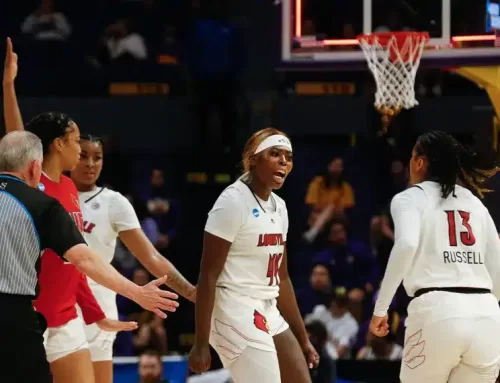Every university has a game plan, detailing how that school wants to help its students and facilities develop. For U of L, the provost’s 21st Century University Inititative is that plan, and it’s operating on a ticking clock.
In 1997, Kentucky’s Postsecondary Education Improvement Act mandated that the University of Louisville become “a premier, nationally recognized metropolitan research university by 2020.” The initiative replaced the previous trajectory-plotting device, the 2020 plan, which was brought about in 2008.
“I think we need a bigger student voice in this,” said Shirley Willihnganz, the university’s provost and chief academic officer. “We need to make some concerted efforts to get together with students, and just do some listening to what they want and need.”
Willihnganz said that because of the state mandate, U of L does not necessarily compare itself to other universities in a traditional way; whereas some universities may obsess over U.S. News and World Reports rankings, U of L’s mission is somewhat more ambiguous, which affords the university the ability to use its own style of metrics for comparison to other universities of its choosing.
“I think there’s some evidence we’re having success,” said Willihnganz, referencing a public relations card called “Extraordinary Success,” which examines the university’s status in 2002, when both Willihnganz and the university president, James Ramsey, were brought on board as the most senior administrative staff, as compared to its status now.
“There’s some really significant growth on there, like (U of L is) the fourth fastest-growing university in the country (by) percent increases in (National Institutes of Health) funding, seventh fastest-growing university in the country in terms of graduation rate,” she said. “These are all things that we use as markers to see if we are making progress.”
Graduation rate, extramural research dollars and the number of graduate students are three areas where Willihnganz said U of L is falling behind. U of L’s graduation rate is 52 percent, but the 2020 goal has been set at 60 to 80 percent. The university is receiving $60 to $70 million in extramural research funding each year, but to compete with other research universities, the number would need to be closer to $100 million. The university also has only 35 Ph.D. programs, whereas top-tier universities have 60 to 70 of these programs.
“What that means is that these other universities are graduating about twice as many graduate students as we are,” said Willihnganz.
Despite her confidence that the university will fulfill the state mandate, Willihnganz admits that the future is never predetermined, comparing the choices between the possible directions for the university to the choice between eight-tracks and cassettes, “both of which are outdated now,” she said. “When it comes down to it, you’d better make the right decision.”
Compared to what other universities are planning, Willihnganz said the plan is “hugely ambitious,” especially considering that “over the last ten years, we have had over $150 million cut from our budget.”
The 2020 Plan was replaced due to “continuing fiscal challenges and a (much different) policy and academic environment” according to the June 2013 Culture of Excellence Committee findings. One of the fiscal challenges identified is the Commonwealth of Kentucky itself, which provides less than 13 percent of the university’s total budget, making it the fifth-highest source of income for the university.
The committee, now disbanded, met every two weeks from March to June of 2013, and effectively acted as a steering body for the focus of the initiative. It was composed of a number of faculty and administrative employees of the university. Each of the colleges were represented by one individual, as were the university libraries and the athletics department. The Board of Overseers sent two members, and one undergraduate and one graduate student were represented.
These individuals were asked to assess the strengths, weaknesses, opportunities and threats — a technique of strategic
planning for large businesses commonly referred to as a SWOT analysis — of the university’s current situation. They were then asked to use these statements to develop a plan for how the university could progress, developing loose “recommendations to improve the student experience.” Due to time constraints, the committee talked mostly about student issues; according to its report, the committee felt that it did not have enough time to fully address how the governance of the university could improve.
The committee based their biweekly discussions on a SWOT survey of 7,500 students, faculty, and staff. The results were more than one-third weaknesses, 40 percent of which were related to the culture of the university. It was for this reason that the Culture of Excellence committee took its name.
Broadly, the committee found that the long-term vision and core values for the university are not commonly known among students, faculty and staff; that campus leadership on all levels could be improved; that there are “‘aristocratic’ vs. ‘peasant’ classes within the (present) culture;” that long periods without salary increases for faculty and staff lead to stagnation; that collaboration and inclusivity need to be fostered within the culture; that faculty and staff need to be trained and recognized for their improvement and that the university should make greater efforts to engage both the students and the Louisville community at large.
The committee then addressed each of these problems with equally broad solutions. For example, to solve the problem of an incohesive set of values among the university community, the committee proposed to “incorporate core values into all aspects of cultural improvement efforts (hiring, promoting, policy development, new employee orientation, performance evaluation processes, training and professional development programs, recognition programs).”
The final step of the process will be for university administration to decide exactly how to execute these goals. This will include what sorts of marketing materials will be used to promote the message of a 21st Century University, as well as what buildings will need to be constructed to support the university’s mission and what programs will need to be created to better serve the student body. The uni- versity plans to begin this phase during the spring semester.
All of these reports are public record, and can be found on the university website, Louisville.edu.




